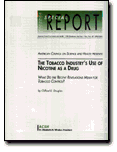
What Do the Recent Revelations Mean for Tobacco Control?
On February 28, 1994, Day One, a magazine show produced by ABC News, aired an expose on the tobacco industry's manipulation of nicotine. The segment (and a follow-up segment which aired on March 7, 1994) resulted from a year-long investigation by Pulitzer Prize-winning journalist Walt Bogdanich, a Day One producer and former Wall Street Journal reporter, and associate producer Keith Summa. The imminent airing of the first segment on a Monday prompted the release the preceding Friday of a remarkable letter by Food and Drug Administration (FDA) Commissioner David Kessler, announcing that in light of the new evidence the FDA would consider regulating tobacco products as drugs. While the FDA reportedly had been interested for some time in pursuing regulatory action against tobacco products, the information obtained by Day One provided the "hook" the FDA felt it needed in order to proceed.
The evidence uncovered by Day One and assembled by FDA investigators illustrates publicly for the first time the extent to which the tobacco industry is capable of and does in fact manipulate the amount and even the presence of nicotine in cigarettes. Before these recent revelations, nicotine generally was perceived to be merely a natural part of the tobacco leaf and an inevitable component of any tobacco product. The potential implication of the new disclosures is substantial.
After four years of independently investigating the subject of nicotine manipulation, I pitched the story to ABC in the fall of 1992 and provided assistance during the investigation. The information and insights offered in this paper come, in part, from this experience. Offered here are background on the investigation's major findings, a look at the broader context in which the Day One story fits and an examination of some of the policy implications it raises.


